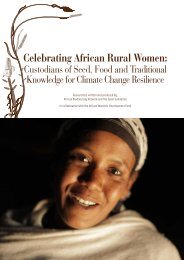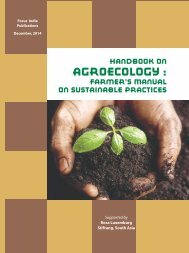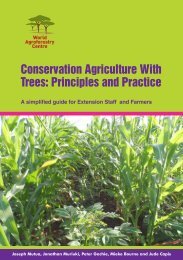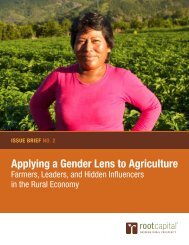1t0SC7l
1t0SC7l
1t0SC7l
You also want an ePaper? Increase the reach of your titles
YUMPU automatically turns print PDFs into web optimized ePapers that Google loves.
Finally, these results showed that all processes taking place under natural fallow were directed<br />
towards the climax equilibrium existing under primary forests. Important differences generally<br />
existed between the primary forest and cropped land or younger fallow. From the bush fallow,<br />
these differences were significantly reduced. While, under the forest fallow, there were almost no<br />
differences with the primary forests. This is thus, an important output of this study in the area<br />
because we can conclude that the optimum fallow that can restore natural soil fertility in the<br />
humid tropics of southern Cameroon is situated between bush fallow and forest fallow. The<br />
fallow period should be at least 10 years. This result is in line with previous studies in West<br />
Africa (Nye and Greenland, 1960) and leads to admit that in the area, soil can recover its<br />
optimum equilibrium under natural fallow only if this fallow is left undisturbed for at least 10<br />
years. The shifting cultivation system can then be replaced by a ‘Rotational Fallow System’ in<br />
which a farmer should come back on a piece of fallow land only after 10 years.<br />
But, in such a ‘rotational fallow system’, over 12 years, only 2 consecutive years will be used<br />
effectively for crop production. This is not sufficient. With the increasing pressure of the<br />
population growth, farmers will more and more shorten the fallow period, hence reducing the<br />
fertility of the soil and the vigour of the forest regrowth when land is abandoned. Grasses may<br />
invade the land and be burnt during the dry season; thus the forest may give way to savannah,<br />
maintained by annual burning. For a sustainable management of the forest zone of southern<br />
Cameroon, this study implies that research has to be carried out on possibilities to intensify crop<br />
production within this rotational system. This intensification can be achieved by prolonging the<br />
cropping period without complete degradation of soil fertility or by shortening the fallow phase<br />
by applying improved fallow technologies. To extend the cropping phase, a solution can be found<br />
in the Integrated Nutrient Management methods defined by Janssen (1993), based on combined<br />
application of mineral and organic fertilisers.<br />
3.3.3 Perennial crops and soil degradation<br />
A young mature (4 to 7 year old) cocoa plantations (YCA), an old (more than 15 year old) cocoa<br />
plantations (OCA), and a mature oil palm plantation (YOP) were selected as perennial<br />
agricultural system, while a pineapple field (YANA) was studied as semi-industrial cultivation<br />
system. Results of these studies are given in Table 3.2 and Figure 3.8.<br />
Soil behaviour under mature (4–7 years) and old (>15 years) cocoa plantations<br />
In the event of land clearing for agricultural development, cocoa cultivation seems to behave like<br />
a fallow system, which allows rapid crown coverage and generates biomass and nutrient levels<br />
approaching those of humid tropical forests after 15 years.<br />
Cocoa plantations are created at the end of cropping period of food crop fields. For that, the land<br />
preparation follows the process of slash and burn agricultural systems and affects soil chemical<br />
and physical status as described in Section 3.3.2. The establishment of the cocoa plantation can be<br />
considered as the beginning of a ‘controlled fallow’. This type of ‘fallow’ is composed of cocoa<br />
tree shrubs as the main tree layer under which develops a dense understorey vegetation. To<br />
maintain the plantation, the understorey vegetation is removed at least once a year. Nutrient<br />
elements released from the slashed biomass by decomposition are either used immediately by the<br />
vegetation in place, or added to the topsoil, increasing the topsoil humus content. This process<br />
results also in the development of an A 1 horizon (Figure 3.4) and the improvement of soil<br />
physical properties. Finally, the effects of cocoa plantation growth are similar to those of the<br />
fallow system in which all processes taking place are directed towards the climax equilibrium<br />
existing under the primary forests.<br />
Soil under oil palm plantations<br />
Only one young oil palm plantation (YOP) situated in the Mvié area was studied, which was not<br />
enough to draw definite conclusions. But, as shown in Figure 3.8, the effects of slash and burn<br />
41








